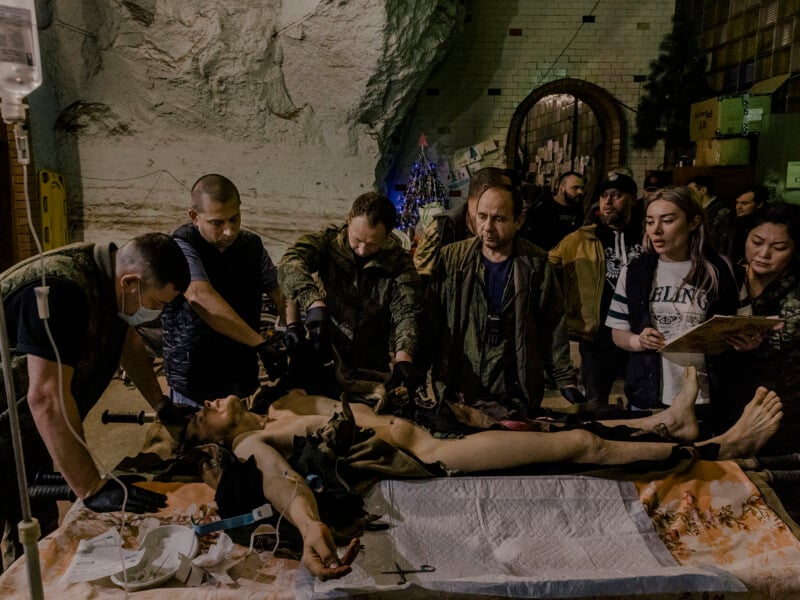Russian Photographer No Longer Welcome at World Press Photo Awards Ceremony

World Press Photo has disinvited a Russian photographer from the awards ceremony in Amsterdam after the competition awarded him a prize in its 2025 competition.
Photographer Mikhail Tereschenko, who works for the state-controlled TASS news agency, was recognized in the European category of the World Press Photo Awards, the winners of which was announced last month.
TASS has been cited as a source of disinformation and Getty Images cut ties with the news agency in March 2020 after it said it was violating editorial policy.
Controversy has arisen since Tereschenko was handed the prize for his coverage of protests in Georgia against the pro-Russian ruling party that have been described as “Putin’s puppet government.”
PetaPixel reported earlier this month that Georgian journalists covering civil unrest and protests in the country face extreme threats of violence, explaining why some Georgia journalists and photographers are upset that a Russian photographer won an award.
Over the weekend, World Press Photo released a statement regarding Tereshchenko.
“Given the increased tensions on the European continent, at this stage we are no longer able to facilitate a guest from a state-controlled Russian organisation,” the statement reads on the World Press Photo website
“As a consequence Mikhail Tereshchenko is no longer invited to the winners programme and the award ceremony in Amsterdam.”
Nevertheless, World Press Photo still stands by its decision to award Tereshchenko the prize, explaining that “the uncomfortable fact is that the awarded project was selected for its own merits—regardless of the identity of the photographer or their employer (which are not shared with the jury) or the views of the photographer. This entry was awarded in accordance with World Press Photo’s judging criteria.”
However, World Press Photo has distanced itself from comments made by Tereshchenko in relation to winning the award. In an interview on March 27, he used the phrase “liberation of Mariupol” when referring to Russia’s invasion of Ukraine.
“As we have previously stated publicly: Russia launched its full-scale invasion of Ukraine, on 24 February 2022. Russian bombardment devastated Mariupol, and included civilian targets such as a maternity hospital and a theater where people were sheltering. Mariupol remains under Russian occupation,” World Press Photo adds.
The organization says it will continue to think about ways to improve its rules and procedures, including with the input of photographers working in places like Ukraine and Georgia. Still, World Press Photo’s Executive Director Joumana El Zein Khoury maintains that any changes must be made with extreme thought and care.
“I hear those saying World Press Photo should reverse the jury’s decision, and it is true that we make a choice not to do so. However, if we disregard or retroactively change our rules in this case, what do we do for the next case or the one after that?” Khoury says.
“We will work to improve our rules and procedures, but must always apply them fairly and without exception. Our contest has a global reach and its rules need to be applicable to very different contexts. Any change of rule to reflect one specific context will also have implications for very different ones. Therefore changes to the rules need to be done with a lot of care, research and consultation.”
Not the Only Controversy
The news that Tereschenko is no longer invited to the winners’ ceremony in the Netherlands comes after World Press Photo apologized for its decision to pair a photo of a six-year-old Ukrainian child suffering from panic attacks following Russian artillery shelling and a wounded pro-Russian militant.

Florian Bachmeier’s photo of the Ukrainian child, Beyond the Trenches, and photographer Nanna Heitmann’s image of the wounded pro-Russian soldier, Underground Field Hospital, were in the same broad “Europe” category.
However, the controversy arose when the World Press Photo website took this geographical similarity further and described the two images as paired without presenting vital context.
“The global jury and World Press Photo apologize for describing these two works, Underground Field Hospital by Nanna Heitmann and Beyond the Trenches by Florian Bachmeier, as paired. There is an obvious difference between a child suffering from the effects of war, and the suffering of a soldier from the invading forces, which are causing this suffering,” the World Press Photo said in a statement.

The World Press Photo organization goes on to say that it should have presented these two images with additional context, including that “According to the United Nations, as of February 21, 2025, ‘more than 12,654 civilian men, women, girls, and boys have been killed, and over 29,392 injured’ since Russia began its full scale invasion. Eighty-four percent of these casualties were in Ukraine-controlled territory. Ukrainian energy infrastructure, medical facilities, homes, and school buildings have also been attacked.”